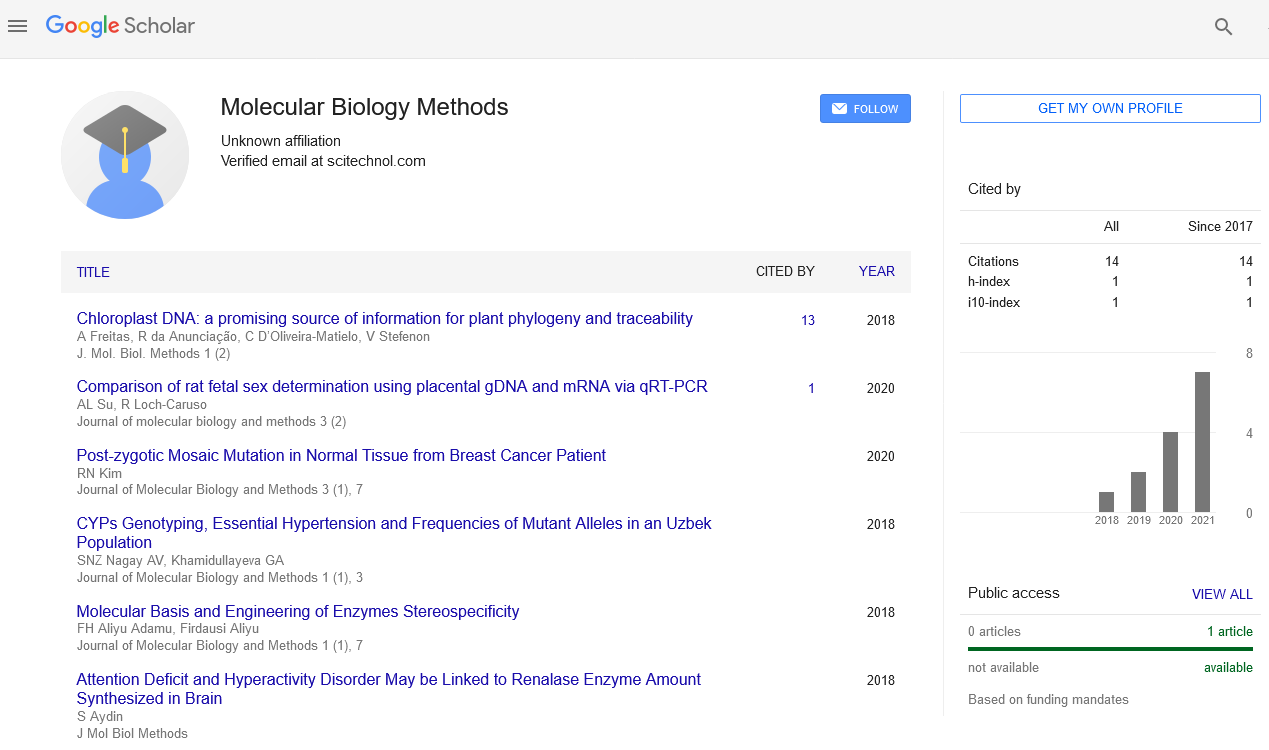Perspective, J Mol Biol Methods Vol: 6 Issue: 2
Biochemical Characterization of Novel Antimicrobial Compounds from Natural Sources
Xiang Hofu*
1Department of Endocrinology, Jining First People's Hospital, Jining, China
*Corresponding Author: Xiang Hofu,
Department of Endocrinology, Jining
First People's Hospital, Jining, China
E-mail: hofuxiang2@di.cn
Received date: 26 May, 2023, Manuscript No. JMBM-23-108092;
Editor assigned date: 30 May, 2023, Pre QC No. JMBM-23-108092 (PQ);
Reviewed date: 14 June, 2023, QC No. JMBM-23-108092;
Revised date: 22 June, 2023, Manuscript No. JMBM-23-108092 (R);
Published date: 29 June, 2023, DOI: 10.4172/jmbm.1000131
Citation: Hofu X (2023) Biochemical Characterization of Novel Antimicrobial Compounds from Natural Sources. J Mol Biol Methods 6:2.
Description
The rise of antibiotic resistance among pathogenic bacteria has become a significant global health threat. As traditional antibiotics lose their efficacy, there is an urgent need for the discovery and development of alternative antimicrobial agents. In recent years, researchers have turned their attention to natural sources, such as plants, marine organisms, and microorganisms, to identify novel bioactive compounds with potent antimicrobial properties. The biochemical characterization of these compounds plays a important role in understanding their mechanisms of action and potential therapeutic applications. Natural sources have long been recognized as reservoirs of bioactive compounds with diverse chemical structures and biological activities. Plants, for instance, produce secondary metabolites that defend against microbial pathogens as part of their survival strategy. Similarly, marine organisms inhabit highly competitive environments, leading to the evolution of unique compounds that offer protection against microbial threats. By tapping into these natural reservoirs, scientists can discover promising antimicrobial compounds that may provide new treatment options against drug-resistant bacteria.
The first step in the biochemical characterization of novel antimicrobial compounds is the isolation and purification of the active substance from the natural source. This process involves extraction, fractionation, and purification techniques, which are tailored to the specific characteristics of the compound and its source. State-of-the-art chromatography, spectroscopy, and mass spectrometry are commonly employed to identify and isolate the active component. Once the antimicrobial compound is isolated, its chemical structure is determined through various spectroscopic and analytical methods. Nuclear Magnetic Resonance (NMR) spectroscopy, Mass Spectrometry (MS), and Infrared (IR) spectroscopy are among the key techniques used for structural elucidation. Understanding the compound rise of antibiotic resistance among pathogenic bacteria has become a significant global health threat. As traditional antibiotics lose their efficacy, there is an urgent need for the discovery and development of alternative antimicrobial agents. In recent years, researchers have turned their attention to natural sources, such as plants, marine organisms, and microorganisms, to identify novel bioactive compounds with potent antimicrobial properties. The biochemical characterization of these compounds plays a important role in understanding their mechanisms of action and potential therapeutic applications.
Moreover, researchers investigate the compound's selectivity towards microbial cells versus mammalian cells to assess its safety profile. Understanding the compound's potential toxicity and side effects is important in determining its suitability for therapeutic use. Furthermore, the stability and solubility of the compound under different conditions are studied to evaluate its feasibility as a pharmaceutical agent. Formulation studies are conducted to develop delivery systems that optimize the compound's bioavailability and enhance its therapeutic potential. In addition to its antimicrobial properties, many natural compounds possess other beneficial bioactivities, such as anti-inflammatory, antioxidant, or immunomodulatory effects. Therefore, researchers also explore potential synergistic effects or combinational therapies that can enhance the compound's overall efficacy and therapeutic scope.
In conclusion, the biochemical characterization of novel antimicrobial compounds from natural sources holds tremendous promise in combating the growing threat of antibiotic resistance. By harnessing the power of nature's chemical diversity, researchers can discover potent bioactive molecules that may serve as the foundation for the development of new antimicrobial drugs. Through a comprehensive understanding of their mechanisms of action, safety profiles, and potential synergies, these compounds may pave the way for innovative therapeutic strategies to address infectious diseases and improve global health. However, further research and rigorous testing are necessary to bring these promising compounds from the laboratory to the clinic, where they can make a tangible difference in patient care.
 Spanish
Spanish  Chinese
Chinese  Russian
Russian  German
German  French
French  Japanese
Japanese  Portuguese
Portuguese  Hindi
Hindi 